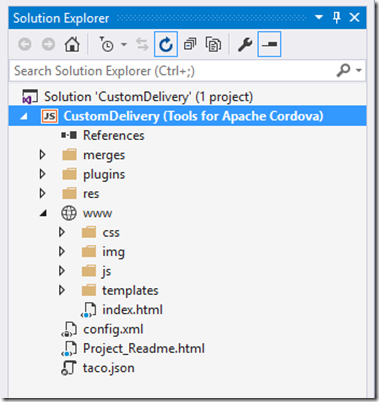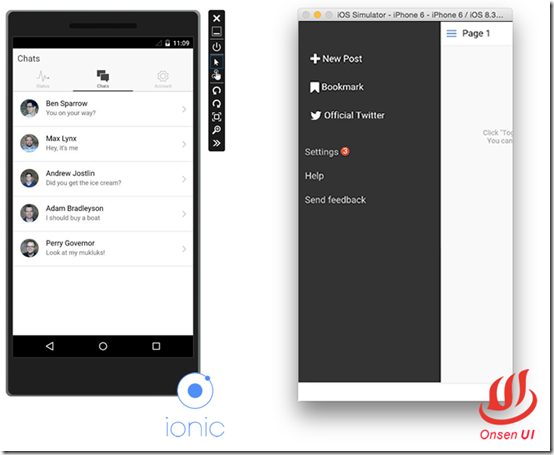Tools for Apache Cordova in Visual Studio 2015 RC
We are excited to announce that Visual Studio 2015 RC will include the Tools for Apache Cordova. Starting today, you can build production quality mobile apps for iOS, Android and Windows using web technologies and nearly 100% shared code across platforms. With support for native device capabilities (e.g. camera, accelerometer, contact), offline scenarios and popular JavaScript frameworks (e.g. Angular, React and Backbone), the Tools for Apache Cordova contain everything web developers need for building cross-platform mobile apps using Visual Studio.
If you’re one of the thousands of developers who followed our previous CTPs, you’ll find a lot of familiar features. The release candidate includes all the same experiences that make Visual Studio a great dev environment – including simple setup, contextual Intellisense, a tight edit-debug loop, connection to back-end services and a fast Android emulator – but there are also some important changes based on user feedback that we think you’ll like. This post reviews just a few, but you’ll have to download the tools to experience them all.
Compatibility with “Stock” Cordova Projects
After trying previous CTP releases, many of you told us that you prefer the productivity of an IDE, but still need the portability afforded by a “stock” Cordova project. Some of you work on teams with mixed development environments. Consequently, there is often a need to open the same project on both Macs and PCs. Others wanted to take advantage of the rich Cordova development community where tutorials and help documents were “just a little different.”
Beginning with this release, the Tools for Apache Cordova share a common project system with ASP.NET 5. This project system is based on the file system and maps precisely to the “stock” Cordova directory structure. Build is federated almost entirely by Node.js and the Cordova framework. All these changes bring to the following benefits –
- You can open projects created by any Cordova-compatible CLI (e.g. Cordova, Ionic).
- You can easily switch to any version of Cordova you like. Simply change the version number in the Config Designer and Visual Studio will automatically acquire the new version on your next build.
- You can move interchangeably between the IDE and command line tools. If you want to perform a custom action (e.g. add a custom platform), open up the command prompt and go to work. Visual Studio will automatically pick up the changes.
- And, you can use the same project in both Windows and Mac development environments.
Note that if you’re migrating your project from a previous CTP release, there are a few extra steps required to open your project the first time in Visual Studio 2015 RC. You can find a comprehensive guide to migrating your project on MSDN.
Grunt, Gulp, Bower and Node-based Workflows
Starting with the RC release, it’s also much easier for you to build Cordova apps using tools familiar to many web developers. Do you use NPM or Bower for package management on a daily basis? No problem. You can use them for Cordova projects, too. Are you a fan of Node-based build-task managers like Grunt or Gulp? Done and done. In fact, we even have a growing library of tutorials designed to help you get started using Gulp with Cordova projects. Learn how Gulp can enable continuous integration with TFS or just perform common Gulp tasks.
New Templates from Ionic and Onsen UI
Like any technology, Cordova development has its share of challenges, and one of the biggest is UI development. It can be difficult to create controls that feel native and perform responsively. Luckily, there are some terrific JavaScript frameworks that make it easy. Two of the most popular are Ionic and Onsen UI. Starting today, we’re happy to announce templates straight from the makers of Ionic and Onsen UI are available in the VS Gallery. Each framework provides a variety of starting points to suit the most common project types.
Of course, if Ionic or Onsen UI aren’t your thing, you can still bring your favorite JavaScript or TypeScript framework with you. Ionic and Onsen UI templates are provided as optional, but are strong starting points for those of you who want to defer the complication of UI so you can begin writing your application logic immediately. In fact, you can see how other frameworks do it by checking out our samples for Angular, Backbone and WinJS.
Fresh Samples, Tutorials and Documentation
If you clicked on the Gulp tutorial link above, you may have noticed that our tutorials and Cordova app samples have moved to GitHub. We hope that the move to GitHub makes it easier for everyone to contribute and use. If you find any issues with our samples or tutorials, send us a Pull-Request or open a GitHub issue. We invite and look forward to your participation so we can grow stronger as a whole.
We are excited for you to tryout Visual Studio 2015 Tools for Apache Cordova and we look forward to seeing your feedback. You can share your feedback directly with the product team via UserVoice, Send-a-smile, Twitter, StackOverflow, or email.
Download VS Enterprise 2015 RC in English to get started right away (or go here for other languages and editions) and don’t forget to check “Tools for Apache Cordova” during setup.
Happy coding!
 |
Ryan J. Salva, Program Manager, Visual Studio Client Tools Team @RyanJSalva Ryan works on the Visual Studio Client Tools team where he looks after HTML, CSS and JavaScript. Today, he focuses primarily on tooling for Apache Cordova and Windows Store applications. However, he comes from a 15 year career in web standards development. |
 |
Ali Satter, Program Manager, Visual Studio Client Tools Team
Ali works on the Visual Studio Client Tools team where he spends his time thinking about how to improve Cordova developer experience inside Visual Studio. |




 Light
Light Dark
Dark
0 comments